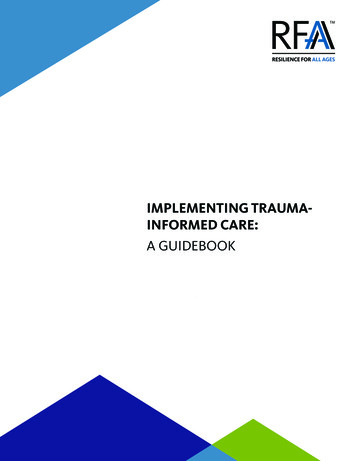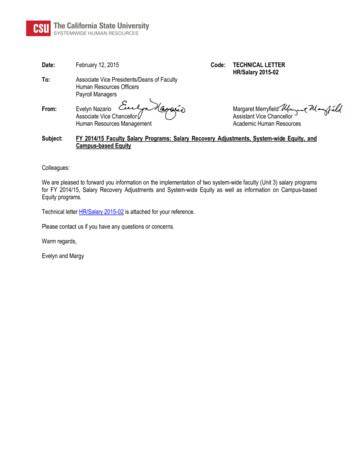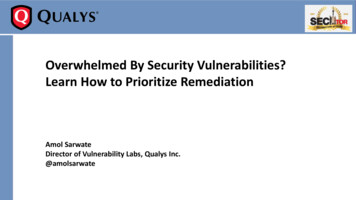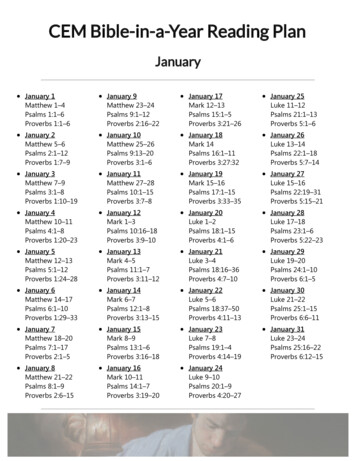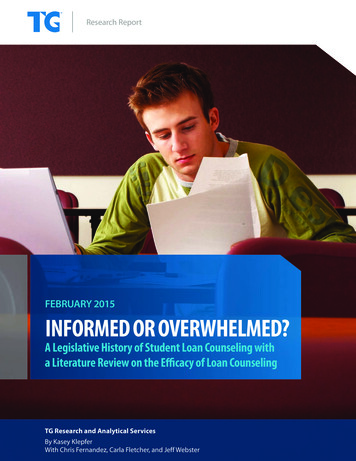
Transcription
Research ReportFEBRUARY 2015INFORMED OR OVERWHELMED?A Legislative History of Student Loan Counseling witha Literature Review on the Efficacy of Loan CounselingTG Research and Analytical ServicesBy Kasey KlepferWith Chris Fernandez, Carla Fletcher, and Jeff Webster
INFORMED OR OVERWHELMED?A Legislative History of Student Loan Counseling witha Literature Review on the Efficacy of Loan CounselingTable of ContentsABOUT THIS REPORT .iACKNOWLEDGEMENTS .iINTRODUCTION . 1SECTION ONE: POLICY CONTEXT . 2Students increasingly rely on loans . 2When grant aid is low, first-generation and low-incomeborrowers turn to loans at greater rates . 3There can be harsh consequences to becomingdelinquent or defaulting on federal student loans . 4There are many tools to help borrowers in repayment . 5SECTION TWO: LEGISLATIVE HISTORY . 6Mandating entrance and exit counseling . 6Electronic loan counseling becomes available. 8Loan counseling today . 9SECTION THREE: LITERATURE REVIEW . 9Are students receiving the information they need from counseling? . 9How the complexity and volume of information can contribute to counseling efficacy .10The delivery method of counseling can affect learning outcomes .11The timing of loan counseling can distract from student learning.14Many students fail to complete loan counseling.15Conclusion .16APPENDICES .17Appendix A: Entrance/Exit Counseling Regulations.18Appendix B: 1988 Belmont Task Force Participants .21Appendix C: Table of Literature Review Findings .22REFERENCES .24
ABOUT THIS REPORTIn 2014, TG conducted four discrete but related studies as part of a multi-phase researchproject on student loan counseling in the United States. These studies include: A literature review on loan counseling and financial education, combined with a history of legislation, regulations,and major government actions pertinent to federal student loan counseling; An interview and observation-based study on the borrower experience with online student loan exit counseling(the subject of this report); An interview and observation-based study on the borrower experience with online student loan entrancecounseling; and A study of the promising practices in financial literacy training and student loan counseling currently employed atschools whose student loan borrowers outperform expectations.Each study is presented in its own report describing the study’s findings and the recommendations they inform.An additional fifth paper will synthesize the findings and implications of the four studies and offer broader conclusionson the policy and practice of student loan counseling. Look for these reports in spring and summer, 2015.ACKNOWLEDGEMENTSTG and the authors appreciate the perspective and support of the National Association of Student Financial AidAdministrators (NASFAA) policy team, in particular, Charlotte Etier Pollack, Megan McClean, and Karen McCarthy.TG’s Laura Kowalski and Michelle Anderson from the policy and regulatory affairs team reviewed this report also.We are grateful for their insights about the legislative history of student loan counseling. The authors, of course,take responsibility for the content of the paper including any errors that may have occurred.
INFORMED OR OVERWHELMED?A Legislative History of Student Loan Counseling witha Literature Review on the Efficacy of Loan Counseling1INFORMED OR OVERWHELMED?A Legislative History of Student Loan Counseling with a LiteratureReview on the Efficacy of Loan CounselingBy Kasey KlepferWith Chris Fernandez, Carla Fletcher, and Jeff WebsterINTRODUCTIONThe stakes are high for borrowers in student loanrepayment. Those who fall into delinquency or defaultcan damage their credit history, have their wagesgarnished, and lose eligibility for federal student aid.First-generation college-goers can have a particularlydifficult time, navigating a gauntlet of college paymentdecisions without the advice and experience of familymembers who have attended college. Given thecomplexity and importance of financial aid decisions,the federal government requires that federal studentloan borrowers complete loan counseling twice:before the first disbursement of a borrower’s first loan(called entrance counseling), and before the studenthas graduated, fallen below half-time enrollment, ordropped out of college (called exit counseling).1However, even with mandatory loan counseling, studentsare entering default or becoming delinquent on their loansat alarming rates. More than 650,000 federal borrowerswho entered loan repayment in fiscal year (FY) 2011defaulted on their federal loan within three years (U.S.Department of Education, 2014). Many more borrowersare delinquent on their loans (Hardekopf, 2013). To avoidthe consequences of delinquency and default, studentsneed to understand their rights and responsibilitiesas borrowers and have a strong grasp of the toolsavailable to help them in repayment. While a sluggisheconomy and rising college costs can make student loanrepayment challenging, borrowers do have optionswhen it comes to staying out of default. Why aren’tmore students using these options? To answer this, TG,in consultation with the National Association of StudentFinancial Aid Administrators (NASFAA)2, first considered thebackground of loan counseling, including why counselingbecame necessary and mandatory. Section I of this reportdescribes the social and policy context for loan counseling.Next, we examined the legislative intent of the counselingrequirement and how counseling evolved over time inresponse to changing regulations. Section II presentsour findings in this area. And last, we reviewed existingresearch on loan counseling’s effectiveness in improvingborrower comprehension and decision-making. Section IIIsummarizes our findings in this area and provides relevantinsights from behavioral economics and other fields forwhich consumer counseling is vital.1Entrance and exit loan counseling are required for all student borrowers with a federal Direct subsidized, Direct unsubsidized,or Direct PLUS loan. For borrowers with a federal Perkins loan, exit counseling is required, and while entrance counseling isnot mentioned by name, institutions are required to provide select information to borrowers before the first disbursementof each loan. Entrance and exit loan counseling are also required for borrowers under the Federal Family Education LoanProgram (FFELP); however, loan originations were ended for this program in 2010. A full list of loan counseling requirementscan be found in Appendix A.2NASFAA personnel consulted with TG in devising the multi-part student loan counseling study. Though NASFAA reviewed thisreport, and others from the study, these reports do not necessarily represent NASFAA’s official policies or positions.While a sluggisheconomy and risingcollege costs can makestudent loan repaymentchallenging, borrowersdo have options whenit comes to staying outof default. Why aren’tmore students usingthese options?
2INFORMED OR OVERWHELMED?A Legislative History of Student Loan Counseling witha Literature Review on the Efficacy of Loan CounselingSECTION ONE: POLICY CONTEXTStudents increasingly rely on loansTODAY, A STUDENT WOULDHAVE TO WORK63 HOURSPER WEEKAT MINIMUM WAGE TOCOVER THE AVERAGECOST OF ATTENDANCE.With the economic downturn in 2008, student loan debt hasgotten more attention from economists, higher educationresearchers, policy makers, and the media. Why? Studentdebt is on the rise. In fact, since 2011, student loan debthas grown by 20 percent (Rice, 2013). Today, cumulativestudent debt tops 1 trillion, the second highest form ofconsumer debt after home mortgages (FRBNY, 2014 Q3).Almost 70 percent of students rely on loans to help payfor college (National Center for Education Statistics, 2013).For many students, taking out student loans can be theirfirst borrowing experience. Given these circumstances,loan counseling offers a great opportunity for educatingnovice borrowers in their rights and responsibilities andemphasizing the consequences of default.Deciding whether to borrow is a complicated one, but formany students the choice is either to borrow or not attendschool. Recent research indicates that half of all first-yearstudents borrow in their first year of college, and half of theremaining students borrow within six years of enrolling(Gladieux & Perna, 2005). Working while in college is oneway that students can minimize or avoid borrowing, but thisstrategy was more effective in the past. In 1980, a studentneed only work 24 hours a week at minimum wage to payfor a bachelor’s degree at a public university. Today, a studentwould have to work 63 hours per week at minimum wageto cover the average cost of attendance (Creusere, Fletcher,Klepfer & Norman, 2015). Students who choose to attendschool part time while they work — or take time off of schoolto work — may be able to finance their education withoutloans, but these students have a greater chance of notfinishing a degree. Working more than 20 hours a week whileattending school has been shown to significantly increase thechance a student will drop out (Pike, Kuh, & Massa-McKinley,2009). Some believe loan counseling could offer students atime when they could consider how certain financial decisions— like working while in school — will affect getting a degree.
3INFORMED OR OVERWHELMED?A Legislative History of Student Loan Counseling witha Literature Review on the Efficacy of Loan CounselingWhen grant aid is low, first-generation and low-income borrowers turn to loans at greater ratesGrant aid can reduce the risk of either borrowing toomuch or working too much, particularly for low-incomestudents (Gladieux & Perna, 2005). However, over thepast two decades, grant aid has not kept up with therising cost of higher education. In 1988, the federal PellGrant, which is designed to help low-income studentsfinance higher education and serve as the cornerstoneof the federal student aid programs, covered more thanhalf the average cost of a degree at a public four-yearinstitution. Today, the Pell Grant only covers around 30percent of a public four-year institution’s tuition, fees,and living expenses (McSwain, 2008). Figure 1 tracksthe percentage of federal grants and loans that makeup total federal aid from 1972 to 2012. From the late1960s through the 1970s, federal grants accounted formore than half of all federal aid. Today, grants makeup around a third of total aid. As grants have becomea smaller portion of aid, low-income students haveturned to student loans at higher rates. Many of theselow-income students may have little if any experiencewith borrowing, or they may have family members whohave had negative experiences. Many of these studentsare also first-generation college-goers, who have tonavigate borrowing without family support. All thesefactors make effective loan counseling crucial.There are reasons to believe that low-income or firstgeneration students could greatly benefit from loancounseling. Disadvantaged students generally have littleknowledge of student loans and the consequences ofborrowing (Perna, 2007). They tend to be more averseto taking out loans, and more willing to enroll part time,stop out, or drop out when facing financing challenges(Cunningham & Santiago, 2008). These borrowers inparticular need quality consumer counseling aboutborrowing. They also need to consider what they willneed to earn in order to repay their loans.Student loans, like grant aid, help many students earna degree or credential. Unlike grant aid however, thedecision to take out a student loan is not simple. Loans arecontracts with complicated terms, legalistic disclosures, anda potentially confusing system of deferment, forbearance,delinquency, and default. Smart borrowing requires that astudent forecast future earnings, which can be difficult in achanging economic environment. Students can have vastlydifferent experiences with loans depending on major, priorexperience with debt and borrowing, income level, and theprospects of finding employment. Over-borrowing or failingto repay can harm a borrower’s financial well-being. All thesefactors drive home the need for loan counseling that helpsborrowers make smart repayment choices.FIGURE 1. Federal Grants and Loans as Percentage of Total Federal Aid: 821987Federal Grants199219972002Federal LoansSource: Source: College Board. (2013). Total Student Aid and Nonfederal Loans in 2012 Dollars over Time.20072012Students can havevastly differentexperiences withloan repaymentdepending on major,prior experience withdebt and borrowing,income level, and theprospects of findingemployment.
4INFORMED OR OVERWHELMED?A Legislative History of Student Loan Counseling witha Literature Review on the Efficacy of Loan CounselingThere can be harsh consequences to becoming delinquent or defaulting on federal student loansWhen managed prudently, student loans can makeboth college and career possible without leaving theborrower an undue financial burden. Missteps, however, canhave harsh consequences. Default can damage credit,which can add expense to borrowing for a car or house, andeven make it difficult to find a job or get an apartment(The Society for Human Resource Management, 2010).Added collection costs and the loss of Treasury offsets(i.e., tax refunds) that come with student loan defaultcan strain finances, while wage garnishment can beembarrassing in that employers become aware of anemployee’s default (See side bar below for more details).These consequences can be avoided by exercising someof the debt relief options available under federal law.The Potential Consequences of Delinquency and Default Damaged Credit HistoryConsumer credit agencies receive notificationof payments, as well as delinquency and defaulton student loans. From 2003–2009, the creditscores of young borrowers were within a fewpoints of non-borrowers. However, since 2009this trend has shifted. In 2012, young borrowershad credit scores that were 15–24 points lowerthan non-borrowers (Brown & Caldwell, 2013).While credit scores typically range from 300to 850, even a small decrease in the score mayincrease the chance of a higher interest rateon loans, especially for those on the cusp of anadverse credit range. Risk to Current or Potential EmploymentA negative credit history from loan delinquencyor default can harm a borrower’s current orpotential employment. Employers can and willaccess an employee’s credit report under thefederal Fair Credit Reporting Act (Rice, 2013).A national survey found that 47 percent ofsurveyed companies use credit backgroundchecks for selected employees, and 13 percentconduct credit checks for all employees (TheSociety for Human Resource Management, 2010). Wage GarnishmentA borrower in default can have up to 25 percent ofhis or her disposable income withheld. However, ifthe borrower is in default on loans held by multiplesources, no single agency may withhold morethan 15 percent. Treasury OffsetA borrower in default could have his or herincome tax refund or other federal moneywithheld through the Treasury Offset Program. Loss of Federal Student Aid EligibilityA borrower in default loses eligibility for federalstudent aid, essential for many students pursuingnew or ongoing education. Release of Student Transcripts and RecordsSome higher education institutions willwithhold official transcripts and academicrecords if a student borrower enters default. Collection CostsTo receive loan funds, borrowers must agreeto pay the cost of collecting on a defaulted debt,which can be up to 24.34 percent of the totalloan amount. Withholding of a Professional LicenseIn some states professional licenses can besuspended or withheld if a borrower entersdefault. This includes licensure for nursing,optometry, real estate, cosmetology, andlaw (Rice, 2013).
INFORMED OR OVERWHELMED?A Legislative History of Student Loan Counseling witha Literature Review on the Efficacy of Loan CounselingThere are many tools to help borrowers in repaymentThe numbers of student borrowers struggling to managetheir debt is particularly troubling given the helpful toolsavailable to prevent delinquency and default. Here is a briefreview of these borrower benefits. Repayment benefitsBorrowers can consolidate their loans for easierrepayment or set up direct debit payments foran interest rate reduction. Grace period and extended delinquency periodStudent borrowers have a six-month grace period afterthey graduate or fall below half-time enrollment andbefore they begin repayment. In addition, borrowershave 270 days after a missed payment before they enterdefault — much longer than typical consumer loans. Loan forgivenessThe federal government offers several loan forgivenessprograms by which qualifying borrowers can get someor most or all of their debt discharged. Varied repayment plansThe standard repayment plan for federal loans structuresrepayment over 10 years, but there are other plansthat offer lower monthly payments designed tohelp students manage their debt. With graduatedrepayment, repayments start low and increase overtime. Borrowers with debt that exceeds 30,000 can takeadvantage of extended repayment and pay reducedamounts each month over a repayment period of upto 25 years. There are also plans that may take intoaccount the borrower’s income and total debt andcap repayment at a percentage of the borrower’sdisposable income if the borrower’s income is lowenough. It would seem that a diverse group of planswould be a great benefit given the diverse needs ofborrowers. However, without effective counseling,borrowers may become confused and overwhelmedby all their options and unable to focus on the bestplan for them (Advisory Committee on StudentFinancial Assistance, 2011). Deferment and forbearanceEligible borrowers can take advantage of deferments,which provide a temporary postponement ofrepayment. Deferments are granted for a variety ofreasons, including enrollment in school or economichardship. During deferment, Direct subsidized loansgenerally do not accrue interest. Forbearance alsoprovides temporary postponement of repayment butcan be more expensive, since interest accrues on all loans.If there are serious consequences to delinquency anddefault — but numerous tools available to help inrepayment — why are student borrowers defaulting ontheir loans at such high rates? Many industry professionalsbelieve that borrowers could be better informed duringloan counseling about the terms and conditions of theirloans, the consequences of delinquency and default, andthe tools available to manage debt. In this next section,we consider entrance and exit loan counseling moreclosely, reviewing how particular counseling requirementscame to be and why they changed over time.5
6INFORMED OR OVERWHELMED?A Legislative History of Student Loan Counseling witha Literature Review on the Efficacy of Loan CounselingSECTION TWO: LEGISLATIVE HISTORYThe Higher Education Act of 1965 (HEA), as amended, isa multifaceted law that provides the authorization andfunding for the majority of the federal government’shigher education programs. The HEA was signed into lawin the context of the Civil Rights Movement, the War onPoverty, and the changing role of women in society. As partof President Lyndon Johnson’s Great Society legislation, theHEA allowed more low-income students to gain access to,and pay for, a higher education.“In a very few moments,I will put my signature onthe Higher Education Actof 1965. The President’ssignature upon thislegislation passed byCongress will swing opena new door for the youngpeople of America. Forthem, and for this entireland of ours, it is themost important door thatwill ever open — thedoor to education. Andthis legislation is the keywhich unlocks it.”— President Lyndon B.Johnson’s remarksupon signing the HigherEducation Act of 1965“In a very few moments, I will put my signature on theHigher Education Act of 1965. The President’s signatureupon this legislation passed by Congress will swing opena new door for the young people of America. For them,and for this entire land of ours, it is the most importantdoor that will ever open — the door to education. Andthis legislation is the key which unlocks it.”— President Lyndon B. Johnson’s remarksupon signing the Higher Education Act of 1965The HEA not only made college more affordable byoffering grants and low-interest loans, but expandededucational opportunities for women, students of color,and the poor. For almost fifty years, the HEA has been themain legislative mechanism for federal support of highereducation, with new programs and funding added throughreauthorizations that occur approximately every five years.Title IV of the HEA was one of the most ambitious sectionsin the law. Title IV altered past models of aid that targetedspecific students (e.g., service members) or areas of study(e.g., science, technology, engineering, mathematics, ordefense-related fields). Instead, Title IV provided grantsfor the neediest students and federally insured loans withinterest subsidies for low- and middle-class students.Created by the HEA, the Guaranteed Student Loan Program(GSLP) expanded access to student loans for low- andmiddle-income students (Cervantes, et al., 2005). It alsoencouraged private lenders to lend to students with littleor no credit history or collateral, since loans were federallyguaranteed and interest subsidized on certain types ofloans. Over time, the GSLP helped raise college enrollmentacross the country.In 1968, Congress passed the first reauthorization of theHEA. In this reauthorization, the Talent Search and UpwardBound Programs of Title IV were combined with the newlycreated Student Support Services, forming what we knowtoday as the TRIO programs (Cervantes, et al., 2005). TRIOprograms provide counseling, interventions, mentorship,and academic tutoring to low-income students. TRIOprograms were created to address concerns that the mostdisadvantaged students knew very little about college,how to pay for it, or how to succeed academically. In manyways, these concerns still exist and are central to federalmandatory loan counseling. Because low-income studentsdefault on their loans at higher rates than other students,there is concern that they know less about the consequencesof borrowing or the tools available to avoid default.Mandatory loan counseling is one strategy to help ensureall students, especially disadvantaged students, knowtheir options and make smart repayment decisions.The HEA also granted the Department of Education (ED)the authority to review schools for their administration offederal programs. ED did not exercise its authority broadlyuntil the late 1980s, when it began using participationin federal student aid programs as a way to ensureschool compliance with rules and regulations, includingregulations regarding entrance and exit loan counseling.Mandating entrance and exit counselingIn the early 1980s, the United States was caught in a globalrecession that contributed to high unemployment andinflation (FDIC, 1997). The HEA reauthorizations of thisdecade signal mounting concerns about the growingcosts of the loan program, borrower default, and thecomplexity of the financial aid process. Policy makers andhigher education leaders then and now shared similarconcerns: Are students borrowing too much and thendefaulting? Will rising student debt hurt the economy(Hansen, 1987; Proceedings, 1986; IHEP, 1997)? By the late1980s, more than 15 percent of student borrowers acrossthe nation were defaulting within two years of enteringrepayment (Department of Education, 2014). Concernabout default was fueled by the actions of for-profit,proprietary institutions, whose students were defaultingat higher rates than students from other higher educationsectors. By 1989, proprietary schools would account formore than 80 percent of all defaults (GAO, 1989).
7INFORMED OR OVERWHELMED?A Legislative History of Student Loan Counseling witha Literature Review on the Efficacy of Loan CounselingPolicymakers were concerned that students wereuninformed about their borrowing — particularly atproprietary institutions — and began taking steps to ensurestudents borrowed responsibly. The HEA reauthorization in1986 marked the first time loan counseling was required bystatute. The HEA, as amended in 1986, required all schoolsto provide exit counseling to their student borrowers for allfederal loan programs that are “made, insured, or guaranteedunder part B or E of Title IV” (Govtrack.us, 2014). To promotea better understanding of repayment and default, exitcounseling must be provided to students just before theygraduate, fall below half-time enrollment, or drop out ofcollege.3 According to statute, counseling must includegeneral information about students’ average indebtedness,anticipated monthly loan payments, and a review of allrepayment options (U.S. Government Printing Office, 2014).In 1987, Secretary of Education William Bennett announceda proposal for reducing federal defaults, which had become“intolerable” (Fraas, 1989). His plan was to make highereducation institutions accountable for the defaults of theirborrowers. In 1989, ED took steps to disqualify institutionswith high default rates from access to financial aid, andbegan formulating new regulations around consumerinformation and borrower counseling (Fraas, 1989). Holdinginstitutions partially responsible for default was controversial(Fraas, 1989). Many lawmakers and higher education leadersfelt the move went too far and risked punishing institutionsthat served disadvantaged students. Many felt that Bennett’sproposals were draconian, dooming institutions to closureby denying their access to federal aid (Fraas, 1989). There wasalso substantial debate over the cohort default rate (CDR)level that would trigger a cut-off of federal aid. SecretaryBennett proposed the level be set at 20 percent. Criticsin Congress worried that a low limit would punish goodinstitutions that served disproportionately at-risk students.They wanted the threshold set at 40 percent. ED’s final rulesrepresented a compromise, requiring institutions to createdefault management plans if their CDR exceeded 20 percent,and invoking harsher penalties — including ineligibilityfor federal aid — for higher rates (Fraas, 1989).Bennett’s proposals were a watershed for ED and itsregulatory power. ED always had the ability to make rules,sanctions, and regulations surrounding the eligibilityfor student aid, but these proposals gave teeth to thatpower. Under Bennett’s direction, ED began using accessto federal loan programs as a way to enforce compliancewith regulations (e.g., mandatory loan counseling) andhold schools accountable for student outcomes (e.g.,default rates).In 1988, a group convened by Rep. Pat Williams of Montana— called the Belmont Task Force — was commissioned toreview the GSLP and student default problems.4 Membersincluded lenders, guarantee agencies, institutions, students,financial aid officers, congressional staff, and ED.5 Thetask force recommended that schools provide entrancecounseling as well as exit counseling. The group alsosuggested that schools collect information on borrowersduring exit counseling, including family and personalreferences (Subcommittee on Postsecondary Education,Committee on Education and Labor, 1988). Rep. E. ThomasColeman of Missouri, a task force member, said, “The schoolsthemselves have a central role in breaking this cycleby providing better counseling and educational supportservices,
2 NASFAA personnel consulted with TG in devising the multi-part student loan counseling study. Though NASFAA reviewed this report, and others from the study, these reports do not necessarily represent NASFAA's official policies or positions. . Student loans, like grant aid, help many students earn a degree or credential. Unlike grant aid .





